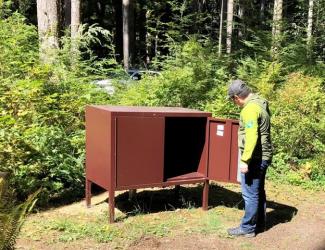Respect Wildlife
Watch wildlife from a distance. Don't feed wildlife as they can become habituated to humans. Don't chase wildlife for photo taking opportunities, and keep pets from harassing wild animals.
Rules for Safe Food Storage & Disposal of Refuse

The Okanogan-Wenatchee National Forest has implemented a new safe food storage regulation across the entire national forest. This order/regulation requires visitors to the forest to store food items in a “bear resistant manner” and to properly dispose of wildlife attractants such as food, beverages, pet food, garbage, uncleaned cookware, and other "smellable" items like scented soap, toothpaste, candles, wildlife carcasses, etc. The food storage order is intended to reduce human/wildlife conflicts. The storage requirement does not apply when preparing or eating food, or when food is being transported or prepared for storage.
What is the food storage order?
The food storage order is a Forest Order intended to help people manage their storage of food to prevent bears and other wildlife from becoming habituated to humans, campsites, and refuse as a source of food. This can help reduce bear-human conflict. The order includes specific requirements for safe storage and disposal of food, garbage, and other attractants.
Is there a fine for not following the food storage order?
Yes. A fine of not more than $5,000 for an individual or $10,000 for an organization, or imprisonment for not more than 6 months, or both.
What is a certified “bear resistant” storage product?
The Interagency Grizzly Bear Committee (IGBC) maintains a list of commercially available approved bear-resistant products. These standards were established through consultation with human-bear conflict experts and wildlife biologists. Please note that IGBC approval does NOT guarantee that the product is BEAR-PROOF and does not guarantee that the container will never be breached by bears.
Do I have to buy a bear resistant container?
Bear resistant containers are just one option that may suit forest visitor needs. For car camping, a hard-sided vehicle may be used or, where provided, a food storage locker. If camping in the forested backcountry, food may be hung in a tree (see graphic). However, in some alpine locations a bear canister may be the most viable option to meet the requirements of the order.
A bear or animal-resistant container is one that has been approved by the Interagency Grizzly Bear Committee (IGBC). Most bear-resistant containers sold in local outdoor retail stores meet these requirements. Soft-sided pop-up campers are not bear-resistant. Most food coolers are not bear resistant and must be secured in a hard sided vehicle.
Image

A person lifts the lid of a bear resistant dumster. |
Image

|
When camping away from a vehicle, suspend all wildlife attractants at least 10 feet above ground and 4 feet from any vertical support (usually in a tree). Suspend or keep containers at least 200 feet away from any tent, latrine, and sleep area. Do not keep the container in your tent!
Any harvested animal carcass must be within sight and control at all times, day or night, unless the carcass is at least a half mile from any camping, sleeping, or latrine area, or 200 yards from a National Forest trail.
Attractants are things like leftover food, bacon grease, scented oils, sunscreen, deodorant, etc. They cannot be buried, burned in an open campfire, or left behind in camp. All attractants must be stored in a sealed container and packed out with garbage or disposed of in a bear-resistant garbage container.
When camping, be sure to store and cook food at least 200 feet away from the campsite. Remember, do not store any food in tents.

- Recreation.gov information for recreating in bear country
- Bear resistant storage bags or containers
- Leave No Trace - Tips for hanging food
Hiking Safely with Mountain Goats

Advice when recreating in areas that Mountain Goats call home.
Keep your distance and stay at least 50 yards away from them. If a mountain goat approaches, slowly move away from it. If it continues to approach, stand your ground, chase it off by yelling, waving clothing, or throwing small rocks. In the fall, give mountain goats more space and move out of their way. Never surround, crowd, chase, or follow a mountain goat. Maintain control of your pets. Do not feed goats or allow them to lick your skin or backpack. If you need to urinate while hiking or camping, please go away from the trail to avoid leaving concentrations of salt and minerals near the trail.


